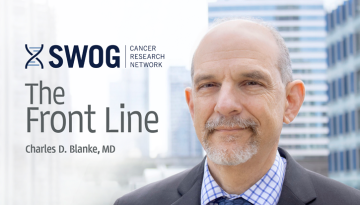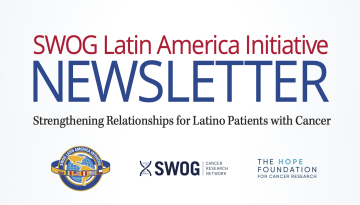Putting the "Public" in Public Powered Research
Our website's front page – ground zero for key branding messages – saves its largest font for this tag line: "Public Powered Cancer Research."
The term Public powered recognizes that our trials are supported with public funds – taxpayer funds – but it also acknowledges that the public powers our trials by volunteering as trial participants.
These facts both allow and oblige us to conduct cancer research in service of the public good, rather than in service of a stock price or some shareholders’ dividends. We tackle important research questions that don’t necessarily come with a direct financial incentive, and, as a rule, our publicly funded trials meet critical needs not likely to be studied through industry research alone.
Those trials (and needs) tend to fall into the following categories (with appropriate examples):
- Studies testing therapies that mix treatment modalities – such as drugs, radiation, and surgery
Our S1931 asks whether patients with advanced kidney cancer who get immunotherapy also benefit from surgery, while S1914, run in collaboration with our colleagues at NRG Oncology, tests whether adding atezolizumab to standard stereotactic body radiation therapy can extend overall survival in patients with inoperable non-small cell lung cancer. - Studies testing non-drug treatment modalities
Trial S1011 reported final results at ASCO last summer, finding that in patients undergoing radical cystectomy for muscle-invasive bladder cancer, an extended lymphadenectomy offered no survival benefit over a standard lymphadenectomy but did come with greater risks. And S1316 reported later in the year that among patients with advanced cancer who developed a malignant bowel obstruction, those who had surgery tended to have a better quality of life than those who did not. - Studies to alleviate patients’ symptoms – including symptoms caused by cancer treatments – and improve their quality of life
Our recently activated S2205 ICE COMPRESS trial aims at this. It tests limb cooling and compression as tools to reduce the peripheral neuropathy many patients experience after treatment with taxane-based chemotherapy. Study S2010 tests whether active monitoring of patients’ symptoms between clinic visits can better control those symptoms and make patients more likely to remain on endocrine therapy. - Studies to optimize – often de-escalate – treatment dose and duration, which can reduce toxicities for patients
We recently launched S2212, the SCARLET trial, which asks whether anthracyclines (which often trail long-term cardiotoxicity in their wake) can be dropped from a standard treatment regimen for early-stage triple negative breast cancer. S1827 tests whether prophylactic cranial irradiation – a standard for reducing the risk of brain metastases in patients who have been treated for small-cell lung cancer – can be skipped with regular MRI surveillance, preserving cognitive functioning in patients without sacrificing overall survival. - Trials that test drug combinations from multiple companies
We have too many of these trials to list, but a model for doing this on a large scale, bringing many companies and other organizations to the table to power clinical trials, is Lung-MAP. This master protocol has partnered with 14 pharma companies, often testing combinations of agents, in 18 sub-studies thus far, with more coming soon. - Cancer prevention studies
Our 800-pound gorillas in this realm were the SELECT and PCPT trials, but we continue to do important prevention studies on a more modest scale. The S0820 PACES study, which closed to accrual recently, is testing whether a combination of two drugs can reduce the recurrence of adenomas and the incidence of secondary colorectal cancers. The S1904 MiCHOICE trial is testing web-based decision support tools – for both patients and providers – to help women at high risk of breast cancer make informed decisions, in partnership with their health care providers, about starting chemoprevention. - Studies of strategies to improve the delivery of cancer care to patients
One study doing this is S1703, which tracks changes in levels of certain tumor markers in blood serum as a means of monitoring disease in patients with breast cancer. The trial compares this strategy to the usual monitoring approach of regular imaging, an approach that can instill regular “scanxiety” in many patients. Our S2108CD trial is testing whether using a centralized genomic tumor board, in conjunction with enhanced educational content, can bring genome-informed care to more patients with cancer, to improve care and reduce health care disparities. - Trials in rare cancers with small patient populations
S1609 (DART) will be our go-to example in this category for years to come– a basket trial that enrolled almost 800 patients with 53 types of rare tumors and that continues to change treatment guidelines. The size of the NCI National Clinical Trials Network, a key to the success of the DART trial, will also be key to reaching the accrual goal in the S2012 rare cancer trial – 189 patients with poorly differentiated extrapulmonary small-cell neuroendocrine carcinomas.
These categories (which are by no means comprehensive) are largely populated by trials conducted with public or foundation funding, including those run by other groups in the NCI’s National Clinical Trials Network.
I am proud to chair a group which tries to improve the lives of our patients through such a broad research program.
Other Recent Stories



